独立主格结构讲解及练习
三种独立主格结构精讲与练习..

思茅一中图书馆 思茅一中图书馆
灵 感 勤 奋
杨 志 明 成 功 路
I. 基本知识:独立主格结构是由名词或代词加 非谓语动词、形容词等构成的一种结构,用 于修饰整个句子。其名词或代词与其后的非 谓语动词、形容词等存在逻辑上的主谓关系。 独立主格结构的类型: 1. 非谓语动词独立主格结构 2. 无动词独立主格结构 3. with复合结构 独立主格结构的用法特点:常置于句首或句 末,与句子之间不能使用任何连接词,主要 用作状语;with复合结构也可用作定语。
Ⅱ. 学习体会与归纳
1. 非谓语动词独立主格结构
n. + non-infinitive pron. to do… to be done 一般式 doing… being done 完成式 having done having been done 过去分词 done 主动 被动
主动 His friends to come tonight, he is trying his best to prepare the dinner. 谓语动词之后 We doubled our efforts, each man 主动 working like two. 与谓语动词同时在进行 The last bus having gone, we had to walk 主动 谓语动词之前 home. doing / having done / to do 的异同 逻辑主 与谓语动词动作的 时间关系 谓关系 doing 与谓语同时 主 having done 谓语之前 动 to do 谓语发生时尚未发生
3. with复合结构 前述的“n. / pron. + 非谓语动词”和“n. / pron. + (being) 表语“两种独立主格结构中,大多可 在其前加上介词with,这就形成了with复合结 构。 to do… doing done with + O + OC n. without adj. adv. prep-phrase
高中英语语法-独立主格讲解与练习
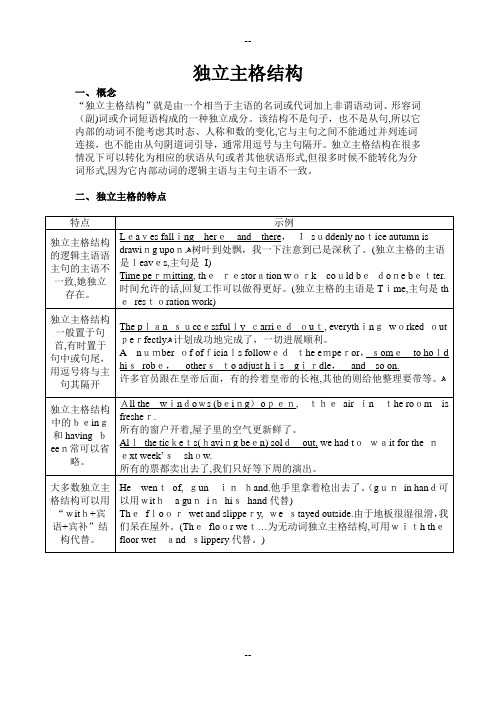
独立主格结构一、概念“独立主格结构”就是由一个相当于主语的名词或代词加上非谓语动词、形容词(副)词或介词短语构成的一种独立成分。
该结构不是句子,也不是从句,所以它内部的动词不能考虑其时态、人称和数的变化,它与主句之间不能通过并列连词连接,也不能由从句阴道词引导,通常用逗号与主句隔开。
独立主格结构在很多情况下可以转化为相应的状语从句或者其他状语形式,但很多时候不能转化为分词形式,因为它内部动词的逻辑主语与主句主语不一致。
二、独立主格的特点1.当独立主格结构中的being done表示“正在被做时”,being不可以被省略。
2.当独立主格结构的逻辑主语是it,there时,being不可以省略。
三、独立主格结构的用法。
放在句首,表示原因时还可放在句末;表伴随状况或补充说明时,相当于一个并列句,通常放于句末。
四、非谓语动词独立主格结构。
“名词或代词+非谓语动词”结构构成的独立主格结构称为非谓语动词的独立主格结构。
名词或代词和非谓语动词具有逻辑上的主谓关系。
1.不定式构成的独立主格结构不定式构成的独立主格结构往往表示还未发生的行为或状态,在句中常作原因状语,有时做条件状语。
Lots of homework to do,I have to stayhome all day.由于很多作业要做,我只好待在家里。
Somany childrentolook after,the mother has toquit herjob.如此多的孩子要照顾,这个妈妈不得不辞掉她的工作。
2.动词+ing形式的独立主格结构动词-ing形式的句中作状语时,其逻辑主语必须是主句的主语,否则就是不正确的。
动词-ing形式的逻辑主语与主句的主语不一致时,就应在动词的-ing形式前加上逻辑主语,构成动词-ing 形式的独立主格结构,逻辑主语与动词间为主谓关系,是分词的动作执行者,分词表示的动作时逻辑主语发出的动作。
ﻫWe redoubled our efforts,each manworking liketwo.ﻫ我们加倍努力,每个人就像在干两个人的活。
高中英语 独立主格结构精讲(配套练习和答案)
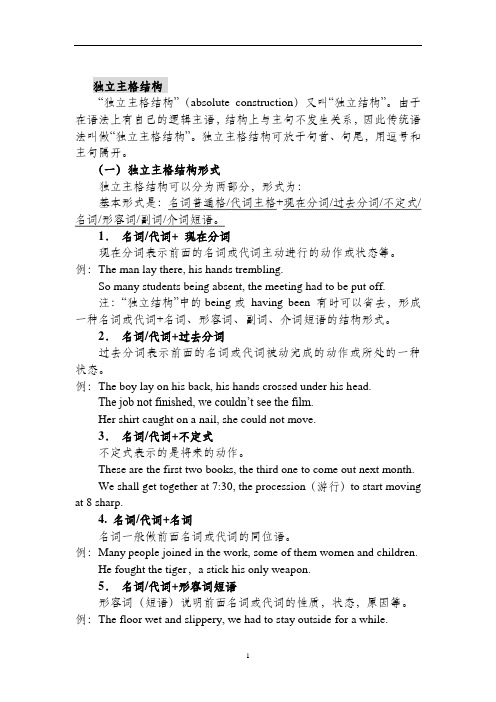
独立主格结构“独立主格结构”(absolute construction)又叫“独立结构”。
由于在语法上有自己的逻辑主语,结构上与主句不发生关系,因此传统语法叫做“独立主格结构”。
独立主格结构可放于句首、句尾,用逗号和主句隔开。
(一)独立主格结构形式独立主格结构可以分为两部分,形式为:基本形式是:名词普通格/代词主格+现在分词/过去分词/不定式/名词/形容词/副词/介词短语。
1.名词/代词+ 现在分词现在分词表示前面的名词或代词主动进行的动作或状态等。
例:The man lay there, his hands trembling.So many students being absent, the meeting had to be put off.注:“独立结构”中的being或having been 有时可以省去,形成一种名词或代词+名词、形容词、副词、介词短语的结构形式。
2.名词/代词+过去分词过去分词表示前面的名词或代词被动完成的动作或所处的一种状态。
例:The boy lay on his back, his hands crossed under his head.The job not finished, we couldn’t see the film.Her shirt caught on a nail, she could not move.3.名词/代词+不定式不定式表示的是将来的动作。
These are the first two books, the third one to come out next month.We shall get together at 7:30, the procession(游行)to start moving at 8 sharp.4. 名词/代词+名词名词一般做前面名词或代词的同位语。
例:Many people joined in the work, some of them women and children.He fought the tiger,a stick his only weapon.5.名词/代词+形容词短语形容词(短语)说明前面名词或代词的性质,状态,原因等。
高中英语之独立主格结构及练习
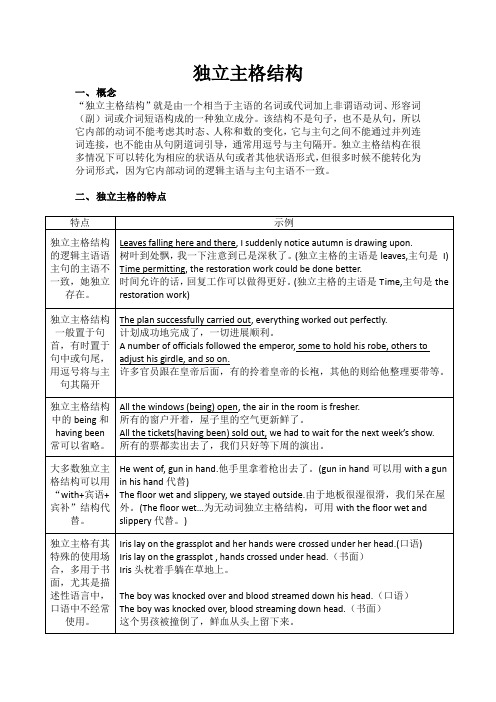
独立主格结构一、概念“独立主格结构”就是由一个相当于主语的名词或代词加上非谓语动词、形容词(副)词或介词短语构成的一种独立成分。
该结构不是句子,也不是从句,所以它内部的动词不能考虑其时态、人称和数的变化,它与主句之间不能通过并列连词连接,也不能由从句阴道词引导,通常用逗号与主句隔开。
独立主格结构在很多情况下可以转化为相应的状语从句或者其他状语形式,但很多时候不能转化为分词形式,因为它内部动词的逻辑主语与主句主语不一致。
二、独立主格的特点【注意】1.当独立主格结构中的being done表示“正在被做时”,being不可以被省略。
2.当独立主格结构的逻辑主语是it, there时,being不可以省略。
三、独立主格结构的用法。
一般放在句首,表示原因时还可放在句末;表伴随状况或补充说明时,相当于一个并列句,通常放于句末。
四、非谓语动词独立主格结构。
“名词或代词+非谓语动词”结构构成的独立主格结构称为非谓语动词的独立主格结构。
名词或代词和非谓语动词具有逻辑上的主谓关系。
1.不定式构成的独立主格结构不定式构成的独立主格结构往往表示还未发生的行为或状态,在句中常作原因状语,有时做条件状语。
Lots of homework to do, I have to stay home all day.由于很多作业要做,我只好待在家里。
So many children to look after, the mother has to quit her job.如此多的孩子要照顾,这个妈妈不得不辞掉她的工作。
2.动词+ing形式的独立主格结构动词-ing形式的句中作状语时,其逻辑主语必须是主句的主语,否则就是不正确的。
动词-ing形式的逻辑主语与主句的主语不一致时,就应在动词的-ing形式前加上逻辑主语,构成动词-ing 形式的独立主格结构,逻辑主语与动词间为主谓关系,是分词的动作执行者,分词表示的动作时逻辑主语发出的动作。
独立主格结构讲解及练习含答案(可编辑修改word版)
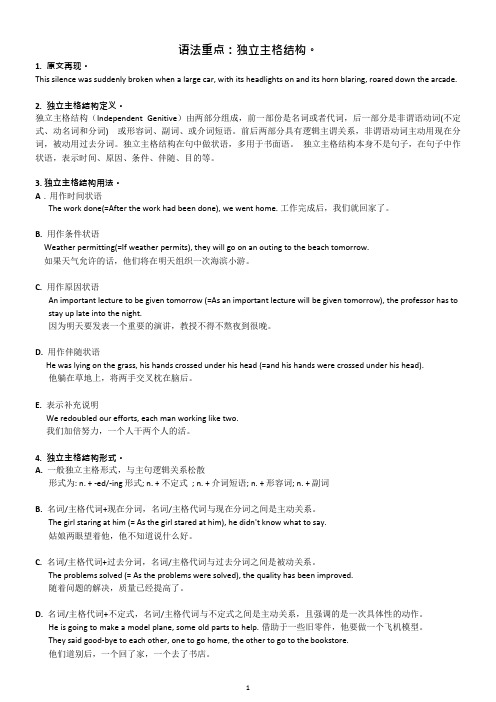
语法重点:独立主格结构。
1.原文再现。
This silence was suddenly broken when a large car, with its headlights on and its horn blaring, roared down the arcade.2.独立主格结构定义。
独立主格结构(Independent Genitive)由两部分组成,前一部份是名词或者代词,后一部分是非谓语动词(不定式、动名词和分词) 或形容词、副词、或介词短语。
前后两部分具有逻辑主谓关系,非谓语动词主动用现在分词,被动用过去分词。
独立主格结构在句中做状语,多用于书面语。
独立主格结构本身不是句子,在句子中作状语,表示时间、原因、条件、伴随、目的等。
3.独立主格结构用法。
A.用作时间状语The work done(=After the work had been done), we went home. 工作完成后,我们就回家了。
B.用作条件状语Weather permitting(=If weather permits), they will go on an outing to the beach tomorrow.如果天气允许的话,他们将在明天组织一次海滨小游。
C.用作原因状语An important lecture to be given tomorrow (=As an important lecture will be given tomorrow), the professor has to stay up late into the night.因为明天要发表一个重要的演讲,教授不得不熬夜到很晚。
D.用作伴随状语He was lying on the grass, his hands crossed under his head (=and his hands were crossed under his head).他躺在草地上,将两手交叉枕在脑后。
(完整版)独立主格结构讲解及练习

(完整版)独立主格结构讲解及练习独立主格结构的用法一、独立主格结构的概念独立主格结构(Absolute Structure)是由名词或代词加上分词等构成的一种独立结构,用于修饰整个句子。
独立主格结构中的名词或代词与其后的分词等构成逻辑上的主谓关系。
这种结构与主句不发生句法上的联系,它的位置相当灵活,可置于主句前、主句末或主句中,常由逗号将其与主句分开。
在句中作状语,相当于一个状语从句。
需特别注意的是,独立主格结构与主句之间不能使用任何连接词。
二、独立主格结构基本构成形式名词(代词)+现在分词;过去分词;形容词;副词;不定式;名词;介词短语)1. 名词(代词)+现在分词例句:The storm drawing nea,the navvy decided to call it a dayThe storm draw ing n ear在句中作:原因状语=Since the storm was drawing nea,the navvy decided to call it a day由于暴风雨即将来临,那个挖土小工决定收工。
(call it a day今天到此为止)例句:Win ter comin g, it gets colder and colder.Win ter comi ng 在句中作:伴随状语=The win ter comes, and it gets colder and colder.冬天来了,天气越来越冷了。
造句:时间允许的话,我就和你一起走。
Time permitt in g, I will go with you. 独立主格作:条件状语=改写:ftime permits, I will go with you.造句:那个姑娘望着他,他不知道说什么好。
The girl stari ng at him, he did n 'k now what to say.独立主格作:时间状语=改写:As the girl stared at him, he did n 'tk now what to say.2. 名词(代词)+过去分词例句:He was listening attentively in class, his eyes fixed on the blackboard.他上课专心听讲,眼睛紧盯着黑板。
独立主格结构讲解及习题.ppt

There being no bus, we had to go home on foot.因
为没有公共汽车,所以我们不得不步行回家
二、独立主格结构在整句中可作以下成分:
1、原因状语 该结构在句中作原因状语时相当于一个原因状语
从句。如:
1).__A______ no bus, we had to walk home.
found a lot of mistakes.
A.When he was correcting B.When he corrected C.Correcting D.all the above
2.____D____by your teachers, you are supposed to be
modest.
A.carrying
B.he was carrying
C.and carrying D.all the above
2.Father came back, _D______ by a monkey.
3、条件状语 独 立 主 格 结 构 作 条 件 状 语 时 可 以 改 为 由 if 引 导的条件状语从句。如: 1).__D______, we'll go to visit the Great Wall. A.Weather permitting B.If weather permits C.If permitting D.A and B 2.)_D____, the patient will recover himself soon. A.If the treatment is in time B.The treatment in time C.The treatment being in time
独立主格结构及精选习题
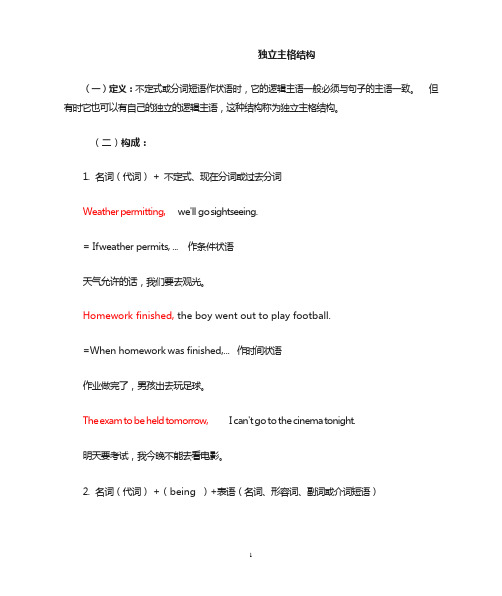
独立主格结构(一)定义:不定式或分词短语作状语时,它的逻辑主语一般必须与句子的主语一致。
但有时它也可以有自己的独立的逻辑主语,这种结构称为独立主格结构。
(二)构成:1.名词(代词) + 不定式、现在分词或过去分词Weather permitting, we'll go s ightseeing.= If w eather permits, ... 作条件状语天气允许的话,我们要去观光。
Homework finished, the boy went out to play football.=When homework was finished,... 作时间状语作业做完了,男孩出去玩足球。
The exam to be held tomorrow, I can't go to the cinema tonight.明天要考试,我今晚不能去看电影。
2.名词(代词) +(being )+表语(名词、形容词、副词或介词短语)It (being) Sunday, we went climbing.= As it was Sunday, ... 作原因状语由于是星期天,我们去爬山。
Tod l ooked a t the million-pound n o te,his eyes (being) wide o pen.托德眼睛睁得大大的看着百万钞票。
S u m m e r vacations (being) over, students returned to s chool.暑假结束了,学生们返回学校。
3.with+ 名词(代词)+宾补,宾补可用现在分词、过去分词、动词不定式、形容词、副词或介词短语。
此句型又称with 复合结构。
a.They pretended to be working hard all night with their lights burning .他们点着灯假装整晚都在努力工作。
独立主格结构完美总结(附习题)[5篇材料]
![独立主格结构完美总结(附习题)[5篇材料]](https://img.taocdn.com/s3/m/c52d003d4531b90d6c85ec3a87c24028915f8535.png)
独立主格结构完美总结(附习题)[5篇材料]第一篇:独立主格结构完美总结(附习题)温新堂个性化VIP一对一教学独立主格结构的用法说明与注意点一、有关独立主格结构的基本概念独立主格结构是一个名词或代词(作为逻辑主语),加上一个形容词、副词、介词短语、分词、不定式等在句中作状语。
它有以下三个特点:1.独立主格结构的逻辑主语与句子的主语不同,它独立存在。
2.名词或代词与后面的形容词、副词、介词短语、分词、不定式等存在逻辑上的主谓关系。
3.独立主格结构一般用逗号与主句分开,但与主句之间不能使用任何连接词。
二、独立主格结构的常见形式独立主格类型1:名词(代词)+现在分词The question being settled, we went home.问题解决之后,我们就回家了。
We shall play the match tomorrow, weather permitting.明天假设天气好,我们就进行比赛。
The monitor being ill, we’d better put the meeting off.班长病了,我们最好还是延期开会吧。
独立主格类型2:名词(代词)+过去分词The job finished, we went home.工作结束后我们就回家了。
The last bus having gone, we had to walk home.最后一班公车已经走了,我们必须走路回家。
More time given, we should have done the job much better.如果给我们更多的时间,我们会把工作做得更好。
独立主格类型3:名词(代词)+不定式Nobody to come tomorrow, we will have to put off the meeting till next week.如果明天没有人来,我们将把会议推迟到下周。
So many people to help him, he is sure to succeed.有如此多的人来帮助他,他一定会成功的。
英语语法独立主格结构讲解及习题

3. 名词/主格代词+不定式(表示将要发生的动作) 名词/主格代词与不定式之间是主动关系,且强调的 是一次具体性的动作。 如: He is going to make a model plane, some old parts to help. 借助于一些旧零件,他要做一个飞机模型。 They said good-bye to each other, one to go home, the other to go to the bookstore. 他们道别后,一个回了家, 一个去了书店。 4.名词/主格代词+形容词(常用来说明名词或代词的 性质,特征或所处的状态) 如: An air accident happened to the plane,nobody alive. 那架飞机遭遇了空难,无一人生还。
5. 名词/主格代词+副词(常用来说明名词或代词 的性质,特征或所处的状态) 如:He put on his sweater ,wrong side out. 他把毛衣穿反了。 The meeting over, they all went home. 会议一结束,他们就都回家了。 6. 名词/主格代词+介词短语(常用来说明名词或 代词的性质,特征或所处的状态) 如:The boy goes to the classroom, book in hand. 那男孩手里拿着书去教室。 7. 名词/主格代词+名词 His first shot failure,he fired again.
finished 1. The test __________(finish) , we began our holiday. was finished 2. When the test __________(finish), we began our holiday 3. Weather _________(permit) , we are going to permitting visit you tomorrow. 4. Therebeing _______(be)no taxis, we had to walk. was 5.Because there _______ (be) no taxis, we had to walk.
英语语法独立主格结构讲解及习题

3.表条件,相当于一个条件状语从句 Weather permitting, the football match will played on Wednesday.(=If weather permits, …)如果天气允许,足球比赛将在周三举行。The book written in simple English, it will be more popular.(=If the book is written in simple English, …)如果这本书用简易英语写的,它会 更畅销。 4.表方式或伴随状语或补充说明 She rushed into the room, a letter in her hand.(=…, with a letter in her hand)她手里拿着封信冲了进来。Saddie sat alone, head bent.(=…, with his head bent.)Saddie独自坐在那里,耷拉着脑袋 5.做定语,相当于一个定语从句 He was walking along the road without any street lights on its both sides.他走在一条2便没有路灯的马路上
独立结构精讲及练习

高考语法复习独立结构精讲及练习状语有时可以由一个名词(代词)和另一成分构成的复合结构充当,称为独立(主格)结构。
独立结构的逻辑主语与句子的主语不同,它独立存在。
名词或代词与后面的分词、形容词、副词、不定式和介词是主谓关系。
独立结构的位置相当灵活,可置于主句前、主句末或主句中,常有逗号与主句分开。
需要特别注意的是,独立结构与句子之间不能使用任何连词。
一、独立主格结构的构成1.名词(代词)+现在分词The storm having destroyed their hut, they had to live in a cav e.Night falling, we hurried home.2.名词(代词)+过去分词He lay on his back, his hands crossed under his head.This done, we went home.3.名词(代词)+形容词She came into the room, her ears red with cold.The floor wet and slippery, we had to stay outside.4.名词(代词)+副词He put on his socks wrong side out.The meeting over, we all went home.5.名词(代词)+不定式Here are the first two volumes, the third one to come out next month.注意:不定式表示将来的动作。
6.名词(代词) +介词短语He walked out of the camp, rifle in hand (= with a rifle in his hand.)She came out of the library, a large book under her arm.二、独立结构在句中的作用1.时间状语The test finished, we began our holiday.(= When the test was finished, we began our holiday.)2.条件状语Weather permitting, they will go on an outing to the beach tom orrow.(=If weather permits, they will go on an outing to the beach to morrow.)3.原因状语The storm drawing near, the worker decided to stop working.(=Since the storm was drawing near, the worker decided to stop wo rking.)4.伴随状语He sat in the front row, his mouth half open.(= He sat in the front row and his mouth was half open.)三、其它形式的独立结构1.在以上所讲的独立结构前加with, 这种结构在句中可作:1)伴随状语With the young man leading, they started toward the mountain.The soldiers marched forward, with guns on their shoulders(=gun on shoulder).He used to sleep with the window open.2) 原因状语He felt uneasy with the whole class staring at him.With Tom away, we have got more room.3)时间状语With everything well arranged, he left his office.2.It形式的独立结构(表示自然现象、时间、距离或环境状况等)It being Monday, the library is closed.It being spring, many kinds of flowers come out.3.倒装结构(即在独立结构中,逻辑主语在后)1) there be形式There being no bus or taxi, we had to go home on foot.2) such形式Such being the case, she had nothing to say.3) 介词短语形式In the sand being the mark of a man’s foot, Crusoe stared at i t, full of fear.独立结构练习I.指出下列句子中的独立结构1.In front of the house was a tall tree, its top well above the tops of the other trees.2.The mid-term examination was over, the final examination to come in two months.3.The boy stood there, his eyes full of tears.4.A young policeman stood in the street, holding a little red flag, h is face red with cold.5.The teacher sat in her chair, surrounded by her students, a happy l ook in her eyes.6.With nothing to eat, he died of hunger.7.A tall man came into the bank, wearing a pair of dark glasses, his face hidden by an upturned (翻起的) collar and a cap pulled over hi s brows.8.Mary left left the office with tears in her eyes.9.Such being the case, you have no reasons for dismissing him.10.He lay on his back, his teeth set, his right hand clenched on his breast, a nd his glaring eyes looking straight upward.II.用独立结构改正下列句子中的错误1.Being freezing cold, she had to dress herself in warm clothes.2.Having finished his homework, we went home.3.A young mother was taking a walk in the schoolyard, followed her li ttle son.4.His bike wrong, he has to walk to school.5.Tom rushed into my room, with his clothes covering with snow.6.They were angry with their money to be stolen.III.单项填空1.The lecture ______, he left his seat so quietly that no one complai ned that his leaving distured the speaker.A.beganB.beginningC.having begunD.being beginning2.Such ______ the case, I have no other choices.A.beingB.isC.wasD.to be3.Darkness ______ in, the young people strolled on the streets.A.setB.settingC.has setD.was set4.With all factors ______ ,we think this program may be better than a ll the others in achieving the goal.A.being consideredB.consideringC.consideredD.are considered5.A new technique ______, the production increased by 20 percent.A.to have been worked outB.having worked outC.working outD.having been worked out6.On the top was the clear outline of a great wolf sitting still, ear s ______, alert, listening.A.pointedB.pointingC.are pointedD.are pointing7.Walter offered us a lift when he was leaving the office, but our wo rk ______, we didn’t accept the offer.A.not being finishedB.not having finishedC.had not been finishedD.was not finished8.There are various kinds of metals, each ______ its own properties (特性).A.hasB.hadC.to haveD.having9.The old man stood under a big tree, ______.A.a pipe in mouthB.with a pipe in mouthC.pipe in mouthD.pipe in his mouth10.The production ______ steadily, the factory needs an ever-increasi ng supply of raw material (原料).A.has gone upB.is going upC.having gone upD.being gone upIV.用独立结构完成下列句子1.Jane ran into the classroom, _____________________________ (手里拿着一个新文具盒).2.______________________ (午饭时间到了), the students all went to the dining-hall.3.A little girl was making paper flowers, ___________________________ _________________________ (她的妈妈面带微笑坐在她旁边).4.Here comes the bus from Yiwu, _____________________________________ _____________ (永康来的班车十分钟后到).5.__________________________ (由向导带路),we set off on foot into the dark night.6.___________________________ (有那么多书要读), I can’t kill time by playing cards.7.At the gate stood a PLA man, __________________________ (手里握着枪).8._____________________________ (做完家庭作业), he went to bed.9.______________________ (她的钱包被偷了), she had no money to buy ev en a bus ticket.10.________________________ (所有的灯都亮着), our teaching building l ooks more beautiful.Keys:II.1.Being前加It 2.Having前加He或His homework finished 3.followe d her little son改为her little son following her 4.His bike wrong改为Something being wrong with his bike或There being something wrong w ith his bike5.covering改为covered6.to be stolen改为stolenIII.1.with a new pencil-box in her hand 2.It being time for lunch 3. her mother sitting beside her with a smile on her face 4.that/the bu s from Yongkang to come in ten minutes 5.(With) The guide leading th e way 6.With so many books to read 7.gun in hand (with a gun in his hand) 8.The/His homework done/finished (With his/the homework done/ finished) 9.Her wallet stolen 10.(With) All the lights onIV. 1—5 CABCD 6—10 AADCC。
独立主格结构完美总结(附习题)
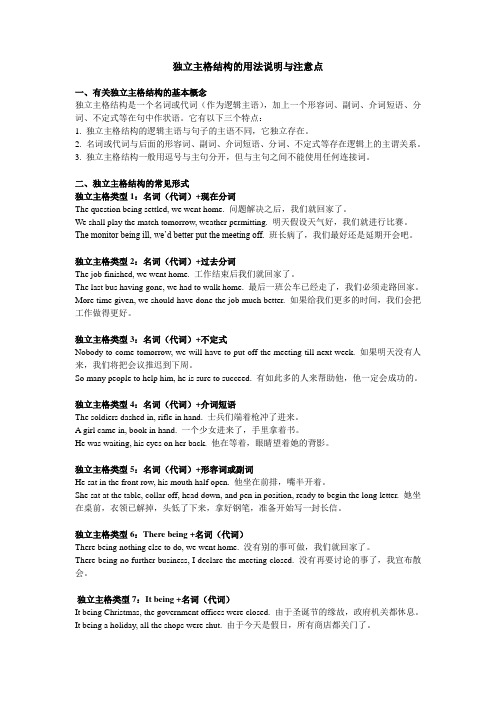
独立主格结构的用法说明与注意点一、有关独立主格结构的基本概念独立主格结构是一个名词或代词(作为逻辑主语),加上一个形容词、副词、介词短语、分词、不定式等在句中作状语。
它有以下三个特点:1. 独立主格结构的逻辑主语与句子的主语不同,它独立存在。
2. 名词或代词与后面的形容词、副词、介词短语、分词、不定式等存在逻辑上的主谓关系。
3. 独立主格结构一般用逗号与主句分开,但与主句之间不能使用任何连接词。
二、独立主格结构的常见形式独立主格类型1:名词(代词)+现在分词The question being settled, we went home. 问题解决之后,我们就回家了。
We shall play the match tomorrow, weather permitting. 明天假设天气好,我们就进行比赛。
The monitor being ill, we’d better put the meeting off. 班长病了,我们最好还是延期开会吧。
独立主格类型2:名词(代词)+过去分词The job finished, we went home. 工作结束后我们就回家了。
The last bus having gone, we had to walk home. 最后一班公车已经走了,我们必须走路回家。
More time given, we should have done the job much better. 如果给我们更多的时间,我们会把工作做得更好。
独立主格类型3:名词(代词)+不定式Nobody to come tomorrow, we will have to put off the meeting till next week. 如果明天没有人来,我们将把会议推迟到下周。
So many people to help him, he is sure to succeed. 有如此多的人来帮助他,他一定会成功的。
独立主格详解及高考题型练习
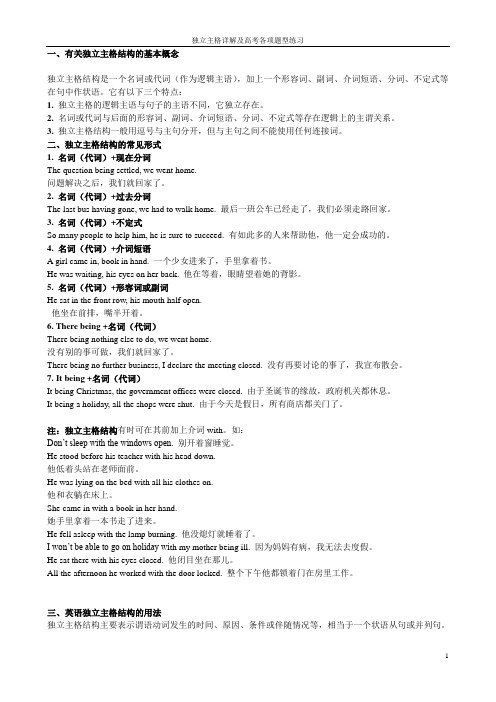
一、有关独立主格结构的基本概念独立主格结构是一个名词或代词(作为逻辑主语),加上一个形容词、副词、介词短语、分词、不定式等在句中作状语。
它有以下三个特点:1.独立主格的逻辑主语与句子的主语不同,它独立存在。
2.名词或代词与后面的形容词、副词、介词短语、分词、不定式等存在逻辑上的主谓关系。
3.独立主格结构一般用逗号与主句分开,但与主句之间不能使用任何连接词。
二、独立主格结构的常见形式1. 名词(代词)+现在分词The question being settled, we went home.问题解决之后,我们就回家了。
2. 名词(代词)+过去分词The last bus having gone, we had to walk home. 最后一班公车已经走了,我们必须走路回家。
3. 名词(代词)+不定式So many people to help him, he is sure to succeed. 有如此多的人来帮助他,他一定会成功的。
4. 名词(代词)+介词短语A girl came in, book in hand. 一个少女进来了,手里拿着书。
He was waiting, his eyes on her back. 他在等着,眼睛望着她的背影。
5. 名词(代词)+形容词或副词He sat in the front row, his mouth half open.他坐在前排,嘴半开着。
6. There being +名词(代词)There being nothing else to do, we went home.没有别的事可做,我们就回家了。
There being no further business, I declare the meeting closed. 没有再要讨论的事了,我宣布散会。
7. It being +名词(代词)It being Christmas, the government offices were closed. 由于圣诞节的缘故,政府机关都休息。
独立主格结构讲解及题目

独立主格结构1一、独立主格结构的概念及基本构成形式独立主格结构(the absolute structure)是由名词或代词加上分词或分词短语构成的一种独立结构,用于修饰整个句子,而不是一个词或词组。
独立主格结构中的名词或代词与其后的分词或分词短语构成逻辑上的主谓关系。
这种结构与主句不发生句法上的联系,独立主格结构的位置相当灵活,可置于主句前、主句末或主句中,常由逗号将其与主句分开。
需特别注意的是,独立主格结构与主句之间不能使用任何连接词。
例如:1)Night enshrouding the earth,nobody could make out what the dark mass was from a distance.(黑夜笼罩大地,谁也看不清远处黑压压的一片是什么东西。
)2)He lay at full length upon his stomach,his head resting upon his left forearm.(他的脊背朝天,四肢伸展,头枕着左臂,直挺挺地趴伏着。
)3)The coward was backing,his face being deathly pale,toward another room.(那个胆小鬼向另一个房间退去,脸色煞白。
)独立主格结构多用于书面语,尤其是描述性语言中,在口语和非正式文体中,一般用从句或两个句子来代替。
例如,上述例句可变为:1)Because night enshrouded the earth, nobody could make out what the dark mass was from a distance.2)He lay at full length upon his stomach.His head rested upon his left forearm.3)The coward was backing toward another room.His face was deathly pale.二、独立主格结构的特殊构成形式独立主格结构除上述基本构成形式,即名词/代词+分词(短语)外,还有如下特殊构成形式。
独立主格结构讲解及练习之欧阳家百创编

独立主格结构的用法欧阳家百(2021.03.07)一、独立主格结构的概念独立主格结构(Absolute Structure)是由名词或代词加上分词等构成的一种独立结构,用于修饰整个句子。
独立主格结构中的名词或代词与其后的分词等构成逻辑上的主谓关系。
这种结构与主句不发生句法上的联系,它的位置相当灵活,可置于主句前、主句末或主句中,常由逗号将其与主句分开。
在句中作状语,相当于一个状语从句。
需特别注意的是,独立主格结构与主句之间不能使用任何连接词。
二、独立主格结构基本构成形式名词(代词)+现在分词;过去分词;形容词;副词;不定式;名词;介词短语)1. 名词(代词)+现在分词例句:The storm drawing near,the navvy decided to call it a day.The storm drawing near在句中作:原因状语=Since the storm was drawing near,the navvy decided to call it a day.由于暴风雨即将来临,那个挖土小工决定收工。
(call it a day 今天到此为止)例句:Winter coming, it gets colder and colder.Winter coming在句中作:伴随状语= The winter comes, and it gets colder and colder.冬天来了,天气越来越冷了。
造句:时间允许的话,我就和你一起走。
Time permitting, I will go with you. 独立主格作:条件状语=改写:If time permits, I will go with you.造句:那个姑娘望着他,他不知道说什么好。
The girl staring at him, he didn’t know what to say.独立主格作:时间状语=改写:As the girl stared at him, he didn’t know what to say.2. 名词(代词)+过去分词例句:He was listening attentively in class, his eyes fixed on the blackboard.他上课专心听讲,眼睛紧盯着黑板。
- 1、下载文档前请自行甄别文档内容的完整性,平台不提供额外的编辑、内容补充、找答案等附加服务。
- 2、"仅部分预览"的文档,不可在线预览部分如存在完整性等问题,可反馈申请退款(可完整预览的文档不适用该条件!)。
- 3、如文档侵犯您的权益,请联系客服反馈,我们会尽快为您处理(人工客服工作时间:9:00-18:30)。
独立主格结构的用法一、独立主格结构的概念独立主格结构(Absolute Structure)是由名词或代词加上分词等构成的一种独立结构,用于修饰整个句子。
独立主格结构中的名词或代词与其后的分词等构成逻辑上的主谓关系。
这种结构与主句不发生句法上的联系,它的位置相当灵活,可置于主句前、主句末或主句中,常由逗号将其与主句分开。
在句中作状语,相当于一个状语从句。
需特别注意的是,独立主格结构与主句之间不能使用任何连接词。
二、独立主格结构基本构成形式名词(代词)+现在分词;过去分词;形容词;副词;不定式;名词;介词短语)1. 名词(代词)+现在分词例句:The storm drawing near,the navvy decided to call it a day.The storm drawing near在句中作:原因状语=Since the storm was drawing near,the navvy decided to call it a day.由于暴风雨即将来临,那个挖土小工决定收工。
(call it a day 今天到此为止)例句:Winter coming, it gets colder and colder.Winter coming在句中作:伴随状语= The winter comes, and it gets colder and colder.冬天来了,天气越来越冷了。
造句:时间允许的话,我就和你一起走。
Time permitting, I will go with you. 独立主格作:条件状语=改写:If time permits, I will go with you.造句:那个姑娘望着他,他不知道说什么好。
The girl staring at him, he didn’t know what to say.独立主格作:时间状语=改写:As the girl stared at him, he didn’t know what to say.2. 名词(代词)+过去分词例句:He was listening attentively in class, his eyes fixed on the blackboard.??他上课专心听讲,眼睛紧盯着黑板。
例句:The meeting gone over, everyone tired to go home earlier.会议结束后,每个人都想早点回家。
造句:工作完成后,他回家了。
The work done, he went back home.= When the work was done, he went back home.3. 名词(代词)+不定式在“名词/代词+动词不定式”结构中,动词不定式和它前面的名词或代词如果存在着逻辑上的主谓关系,动词不定式则用主动的形式;如果是动宾关系,则用被动形式。
例句:The four of us agreed on a division of labor, each to translate a quarter of the book.我们四人同意分工干,每人翻译全书的四分之一。
例句:Many trees, flowers, and grass to be planted, our school will look even more beautiful.种上许多的树、花和草后,我们新建的学校看上去将更美。
造句:还有很多作业要做,我不能和你走。
A lot of home work to do, I can’t go with you.4. 名词(代词)+形容词Computers very small, we can use them widely.电脑虽小,我们却能广泛地利用它们。
he stood silent in the noon sunlight, its door open.5. 名词(代词)+副词The meeting over, our headmaster soon left the meeting room.散会了,校长很快就离开了会议室。
灯熄了,我们不能继续工作了。
造句:The lights off, we could not go on with the work.6. 名词(代词)+名词His first shot failure,he fired again.他第一枪没击中,又打了一枪。
Two hundred people died in the accident, many of them children.两百人死于事故,其中有许多儿童。
7. 名词(代词) +介词短语The huntsman entered the forest, gun in hand.那位猎人手里提着枪走进了树林。
三、with,without 引导的独立主格结构with ( without)+宾语(名词/代词)+宾语补足语,宾语通常由名词或代词充当,但代词一定要用宾格。
上文的独立主格结构的几种情况都适用于此结构。
The girl hid her box without anyone knowing where it was.小女孩把盒子藏了起来,没有人知道它在哪里。
(without +名词/代词+动词的-ing形式)Without a word more spoken, she left the meeting room.她没再说什么话就离开了会议室。
(without+名词/代词+动词的-ed形式)The kid feels excited with so many places of interest to visit.有这么多的名胜可参观,小孩很激动。
(with+名词/代词+动词不定式)?The boy was walking, with his father ahead.??父亲在前,小孩在后走着。
(with+名词/代词+副词)?He stood at the door, with a computer in his hand. 或He stood at the door, computer in hand.?他站在门口,手里拿着一部电脑。
(with+名词/代词+介词短语)With his son so disappointing, the old man felt unhappy.由于儿子如此令人失望,老人感到很不快乐。
(with+名词/代词+形容词)在with (without) 的复合结构中,多数情况下with 能省略,但without 不能省略。
造句:老师走进教室,胳膊下面夹了一本书。
The teacher walked into the classroom, with a book under his arm.造句:老师坐在椅子上,周围一群学生围着他。
The teacher is sitting in the chair, with a group of students around him造句:工作完成了,他回家了。
With the work done, he went back home.造句:由那个男孩带路,我们很容易就找到了那奇怪的洞。
With the boy leading the way, we had no trouble finding the strange cave.四、独立主格结构的句法功能独立主格结构在句中一般作状语,表示时间、条件、原因、伴随状况等,还可以作定语。
1. 作时间状语?????? My shoes removed,I entered a low-ceilinged room,treading cautiously on the soft tatami matting.我脱掉鞋子后,走进一间屋顶很低的房间,小心翼翼地踩在柔软的塌塌米垫子上。
?????? The governor pondering the matter,more strikers gathered across his path.总督思考问题时,更多的罢工工人聚集在他要通过的路上。
2. 作条件状语?????? Weather permitting,they will go on an outing to the beach tomorrow.如果天气允许的话,他们将在明天组织一次海滨郊游。
?????? Such being the case,you have no grounds for dismissing him.如果情况如此的话,你没有理由解聘他。
3. 作原因状语?????? The boy leading the way, we had no trouble finding the strange cave.由那个男孩带路,我们很容易就找到了那奇怪的洞。
?????? There being no further business to discuss, we all went home.没有别的事可讨论,我们都回家了。
4. 作伴随状语或补充说明?????? I took my ticket,and marched proudly up the platform,with my cheeses,the people falling back respectfully on either side.我拿着车票还有我的奶酪,雄赳赳气昂昂地跨步走向月台。
人们似乎很尊敬我,纷纷向两边退去。
?????? Ten students entered for the competition, the youngest a boy of 12.十个学生报名参加了这次竞赛,年纪最小的是个12岁的男孩。
比较:??动词不定式表示动作没有发生或即将发生,动词-ed形式表示动作已经结束,动词-ing形式往往表示动作正在进行。
??The manager looks worried,many things to settle. 经理看上去很着急, 有这么多的事情要处理。
(事情还没有处理,而且是由经理本人来处理,用不定式to settle)??The manager looks relaxed, many things settled. 许多事情已经处理好了,经理看上去很轻松。
(事情已经处理好了,用动词-ed形式settled表示动作已经结束)??The food being cooked, the boy was watching TV. 小孩一边做饭,一边看电视。
(两个动作同时进行)??The food cooked, the boy went to bed.??饭做好了,小孩去睡了。
